The History of the Royal Palace of Caserta
Designed by Luigi Vanvitelli at the behest of Charles III of Bourbon, the Royal Palace is an emblematic example of late 18th-century Baroque architecture.

Guide to the most fascinating places in the province: art, history, and nature in Campania.
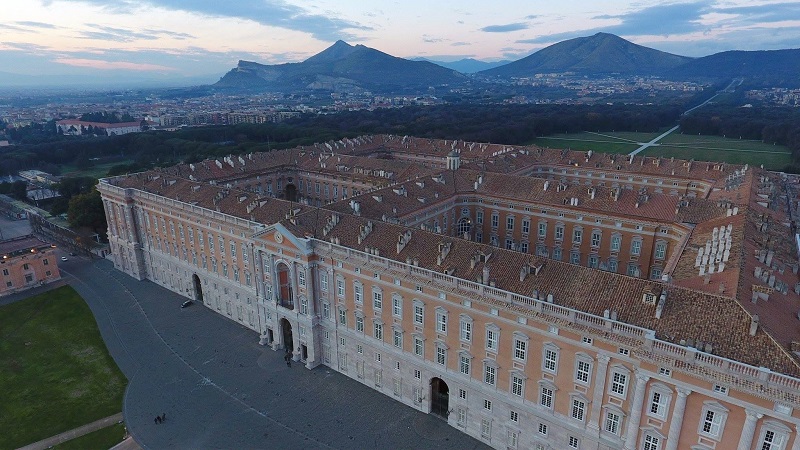
The Royal Palace of Caserta, a masterpiece of 18th-century Italian Baroque, is one of the largest and most fascinating royal residences in Europe. Designed by Luigi Vanvitelli at the behest of the Bourbon kings of Naples, the Palace is a UNESCO World Heritage Site and represents a masterpiece of architecture, art, and landscape.
In addition to the lavish royal apartments, a visit to the Royal Park, which extends for over 120 hectares with scenic fountains, waterfalls, and the evocative English Garden, considered one of the most beautiful in Europe, is a must.
Easily reachable by high-speed trains from Rome and other major cities, the Palace is located just a few minutes' walk from the Caserta railway station. It is the ideal destination for a cultural day trip or a weekend exploring Bourbon Campania.
For more historical details, click on Read more. If you wish to purchase tickets directly, click on the "Buy Tickets" button below: this will also support our work.
After exploring the Royal Palace of Caserta, one of the masterpieces of European Baroque, it is advisable to continue your visit in the surroundings, especially if you are traveling by car. Just a few minutes away is the Carolino Aqueduct, also designed by Luigi Vanvitelli and an integral part of the Vanvitellian complex, declared a UNESCO World Heritage Site.
Do not miss the Wood of San Silvestro, a natural area ideal for walks in nature, and the Belvedere of San Leucio, an ancient monumental complex that housed the famous silk manufacture. Both places represent fundamental stops to discover the historical, artistic, and natural heritage of Caserta.
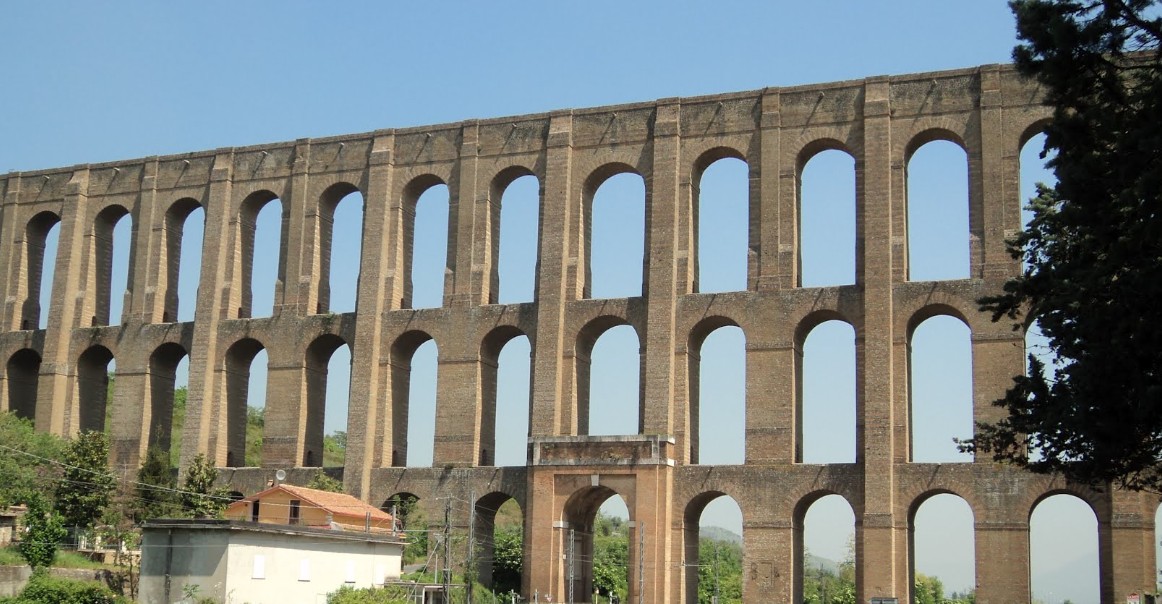
The Carolino Aqueduct, also known as the Vanvitellian Aqueduct, is an extraordinary engineering work designed by Luigi Vanvitelli in the 18th century to supply water to the Royal Palace of Caserta, its park, and the cultivations of the Royal Site of San Leucio.
The aqueduct extends for about 38 km and crosses valleys and hills with a series of majestic arches, among which the visible section of the Valle di Maddaloni stands out, a symbol of the architectural genius of the Bourbon era. The entire system has been included among the UNESCO UNESCO World Heritage Sites, together with the Royal Palace and the Belvedere of San Leucio.
Today, the Carolino Aqueduct can only be visited from below (the upper walkway of the bridge can only be crossed during some special openings) and represents an unmissable stop for those wishing to discover the great hydraulic works of Bourbon Campania.
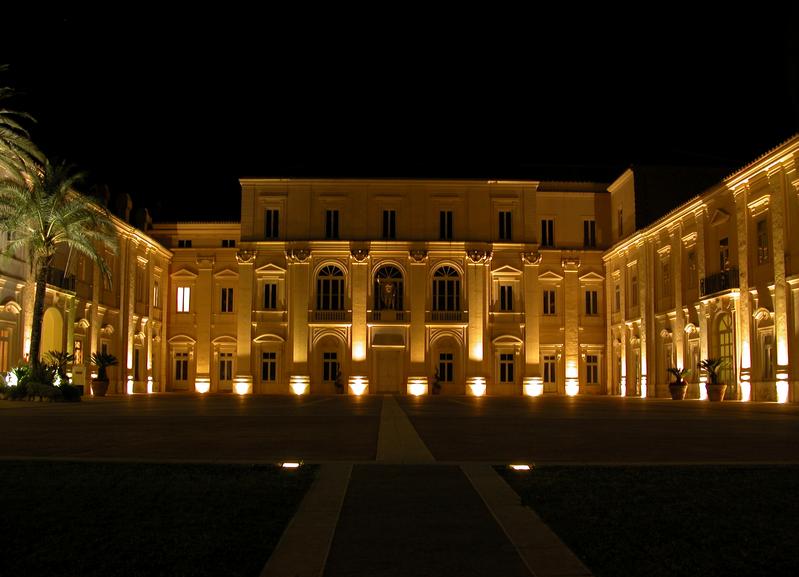
The Belvedere di San Leucio is an extraordinary monumental complex situated on a panoramic hill behind the Royal Palace of Caserta. Commissioned by King Ferdinand IV of Bourbon in the 18th century, the site includes royal apartments, a historic silk factory, and an elegant Italian garden..
In 1778, the Real Colonia di San Leucio (Royal Colony of San Leucio) was founded, a utopian industrial community where the Leggi Leuciane (Leucian Laws) were in force, a set of revolutionary rules for the time that promoted equality, merit, education, and social welfare for the workers and their families.
Today, San Leucio is a symbol of social and technological progress in the history of the Kingdom of Naples. In 1997, it was recognized as a UNESCO World Heritage Site together with the Royal Palace of Caserta and the Carolino Aqueduct, forming a cultural unique of European significance.
The Bosco di San Silvestro (Wood of San Silvestro), located behind the Royal Palace of Caserta, is a splendid nature reserve and an integral part of the Vanvitellian complex. Once a royal hunting reserve, today it is a protected natural park managed by WWF Italia.
This green lung of the province of Caserta extends over 76 hectares and is home to a great variety of native flora and fauna. Visitors can walk along trails immersed in nature, participate in guided tours, educational activities for children, birdwatching, and cultural events.
The wood is easily accessible and represents an ideal stop for those who wish to alternate a visit to historical monuments with a refreshing outdoor experience. The Bosco di San Silvestro in Caserta is perfect for families, hikers, and nature lovers."
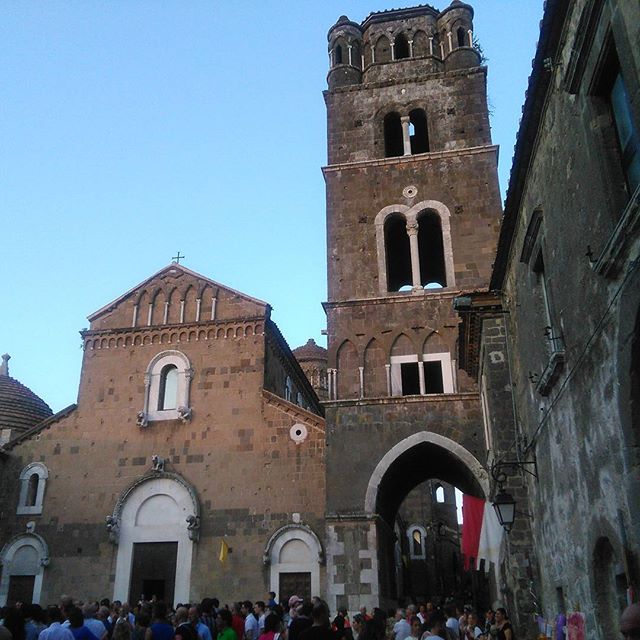
Casertavecchia, an ancient medieval village situated on the hills overlooking the plain of Caserta, is one of the most fascinating tourist destinations in Campania. Immersed in an atmosphere of times past, it captivates visitors with its stone alleys, historic houses, and the Romanesque Cathedral, topped by an imposing bell tower that tells centuries of history.
Ideal for those seeking a journey into the past amidst authentic medieval glimpses, Casertavecchia offers spectacular views of the surrounding region and represents an unmissable stop for lovers of culture, photography, and romantic strolls.
Discover Casertavecchia, the hidden gem of the province of Caserta, perfect for a day trip dedicated to history and timeless beauty.
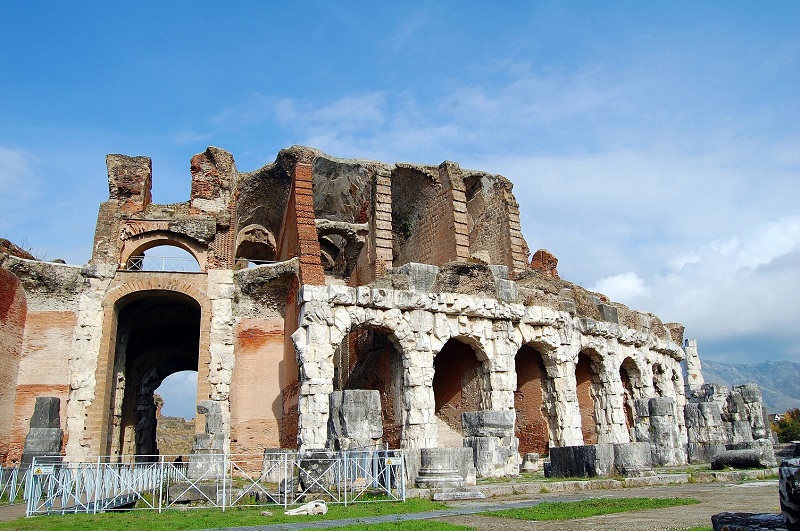
The Campanian Amphitheater, located in the heart of Santa Maria Capua Vetere, in the province of Caserta, is the second-largest Roman amphitheater in size after the famous Colosseum in Rome. Built between the late 1st and early 2nd centuries AD, it represents one of the most extraordinary testimonies of Roman architecture and the gladiatorial culture of ancient Rome.
With an estimated capacity of over 40,000 spectators, this majestic monument was the scene of gladiatorial combats, including those of Spartacus, the legendary rebellious gladiator. Today, it is possible to visit the arena, the fascinating underground tunnels, and the Gladiator Museum, for an authentic immersion in Roman history and archaeology.
Easily reachable from Naples, Caserta, and Rome, the Campanian Amphitheater is an unmissable tourist destination in Campania for those wishing to discover the wonders of antiquity. The site is accessible and well-integrated into the modern urban fabric, making the visit comfortable and engaging.
For updated information on opening hours, tickets, and historical curiosities, click on Read more and plan your visit to one of Italy's most important archaeological sites.
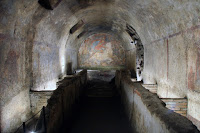
The Mitreo di Santa Maria Capua Vetere (Mithraeum of Santa Maria Capua Vetere) is one of the best-preserved Mithraic places of worship in Italy and represents a precious testimony to the cult of the god Mithras, widespread among the soldiers of the Roman Empire. Located a few steps from the Campanian Amphitheater, this extraordinary underground sanctuary preserves original frescoes dating back to the 2nd-3rd century AD, including a depiction of the god Mithras in the act of slaying the bull, the central symbol of the Mithraic religion.
The visit to the Mitreo is included in the entrance ticket to the Campanian Amphitheater, thus offering a unique opportunity to deepen the knowledge of Roman mystery religions within an integrated archaeological itinerary. The site is easily reachable and accessible, perfect for enthusiasts of history, archaeology, and ancient culture.
Read more to discover history, curiosities, and useful details for your visit to the Mitreo.
The Archaeological Museum of Ancient Capua, located in Santa Maria Capua Vetere in the province of Caserta, is one of the most fascinating places to explore the history and culture of ancient Capua, one of the most important cities of Roman Italy. The museum preserves and enhances numerous archaeological finds from the excavations of the surrounding area, including ceramic objects, mosaics, statues, epigraphs, and funerary artifacts.
Inside the museum itinerary, visitors can admire collections that recount the daily, religious, and political life of ancient Capua, famous for having been one of the largest metropolises of the Roman world and the homeland of Spartacus. Particularly interesting is the section dedicated to the Temple of Mithras and the Mithraic cult, with rare and evocative testimonies.
The museum is part of the archaeological circuit that also includes the Campanian Amphitheater and the Mitreo, offering a complete cultural experience in the heart of ancient Campania. Thanks to its strategic position and the richness of the exhibited heritage, the Archaeological Museum of Ancient Capua represents an unmissable stop for enthusiasts of archaeology, Roman history, and cultural tourism.
To find out about opening hours, rates, and guided tours, please visit the official website.

The Reggia di Carditello, also known as Real Sito di Carditello, is a Bourbon residence located in San Tammaro, in the province of Caserta, in the heart of rural Campania. This splendid example of Neoclassical architecture was commissioned by Ferdinand IV of Bourbon in the 18th century as an agricultural estate and hunting lodge for the royal family.
Today, the Reggia represents one of the most evocative cultural sites in the region, immersed in the green of the Piana del Volturno, and stands out for its extraordinary historical and landscape value. The central building, with original frescoes, stuccos, and decorations, is flanked by spaces intended for the breeding of royal horses and ancient country paths.
Restored and reopened to the public after years of neglect, the Reggia di Carditello is now home to cultural events, guided tours, educational activities, and projects for the enhancement of the territory. It is an ideal stop for those wishing to discover a lesser-known but fascinating corner of the Bourbon heritage in Italy.
Find out more about its history, opening hours, events, and how to visit the Reggia di Carditello by clicking on Read more.

The Basilica of Sant’Angelo in Formis is a masterpiece of medieval architecture located in Sant’Angelo in Formis, a hamlet of the municipality of Capua, in the province of Caserta. Built in the 11th century on the remains of an ancient Roman temple dedicated to Diana Tifatina, the basilica is famous for its extraordinary cycle of Byzantine and Lombard frescoes that entirely decorate the interior.
This sacred place represents a fundamental point of reference for the history of Romanesque art in Campania and testifies to the meeting of different artistic cultures. The structure still retains its religious function today and is immersed in a suggestive hilly landscape on the slopes of Monte Tifata, offering a visit that combines spirituality, art, and nature.
Easily reachable from Naples and Caserta, the Basilica is an ideal destination for lovers of cultural tourism, history, and sacred art. The site can be visited all year round and represents an unmissable stop along the historical itineraries of ancient Campania.
For more details on visiting hours, religious events, and historical information, click on Read more.
The Campanian Museum of Capua, located in the historic center of Capua, in the province of Caserta, is one of the most important archaeological museums in Southern Italy. Housed in the ancient Palazzo Antignano, the museum preserves a very rich collection of archaeological finds, works of art, and historical testimonies from the ancient city of Capua and its territory.
Among the most famous sections is that of the Matres Matutae, an exceptional collection of female votive statues in tufa, unique in the European archaeological landscape. The museum also documents the evolution of Capuan civilization from the pre-Roman era to the Middle Ages, with important Oscan-Samnite, Etruscan, and Roman finds.
The Campanian Museum represents a fundamental stop for those wishing to explore ancient art, the history of Campania, and the cultural roots of Southern Italy. Perfectly accessible and well-organized, it is an ideal destination for scholars, tourists, and families looking for an educational and engaging experience.
For information on opening hours, ticket prices, and cultural events, please visit the official website.
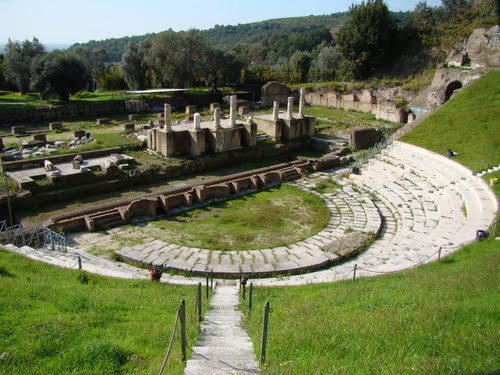
The Roman Theatre of Sessa Aurunca, located in the archaeological area of ancient Sessa Aurunca in the province of Caserta, is one of the most impressive and best-preserved Roman theatres in Campania. Built during the Augustan period and expanded in the 2nd century AD, it could accommodate over 7,000 spectators and was used for theatrical performances, public ceremonies, and civil events.
Framed by Mount Massico and overlooking the Gulf of Gaeta, the theatre stands out for its monumental structure, the perfectly visible cavea (seating area), and the excellent state of preservation of the stage and internal corridors. Today, it represents one of the main archaeological attractions of the region and is a venue for cultural events, performances, and guided tours.
The archaeological site is easily reachable from Naples, Caserta, and Formia, and is an integral part of the tourist itinerary of ancient Campania. A visit to the Roman Theatre of Sessa Aurunca is a unique opportunity to immerse yourself in the history and engineering of Roman architecture.
For more information, click on read more.

The Roman Theatre of Teano, located in the ancient Teanum Sidicinum in the province of Caserta, is one of the most extensive and fascinating examples of Roman theatrical architecture in Campania. Built between the end of the 2nd and the beginning of the 1st century BC, the theatre could accommodate up to 10,000 spectators, making it one of the largest in the Roman world.
Built by exploiting the natural slope of the terrain, the theatre still preserves the majestic cavea (seating tiers), the stage, and part of the original architectural decorations. This extraordinary archaeological site is immersed in a suggestive hilly landscape and testifies to the cultural and political importance of Teano in Roman times.
The Roman Theatre of Teano is easily reachable from Naples, Caserta, and Benevento, and is an integral part of the tourist itineraries of ancient Campania. Today, it hosts theatrical performances, cultural events, and guided tours that enhance the history and archaeology of the territory.
For more historical information, click on read more.
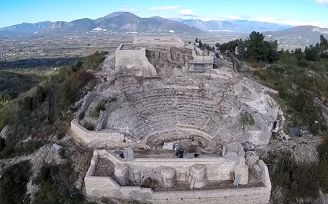
The Teatro Tempio di Pietramelara (Temple-Theater of Pietramelara) is a fascinating archaeological site located in the municipality of Pietramelara, in the province of Caserta, in the heart of inland Campania. This monumental complex from the Roman era combines the characteristics of an ancient theater with those of a place of worship, making it unique in the archaeological landscape of Southern Italy.
Nestled in a suggestive natural landscape, at the foot of Monte Maggiore (Mount Maggiore), the site preserves remains of the semicircular cavea (seating area), parts of the orchestra, and foundations that testify to the ancient presence of an adjacent temple, probably dedicated to a local or Roman deity. The Temple-Theater was a point of reference for religious rites, scenic performances, and civic assemblies.
Today, the complex is the subject of enhancement and archaeological studies, and can be visited during cultural events, FAI (Italian Environment Fund) days, or by reservation. It's a perfect stop for those seeking little-known but historically rich sites, away from the most crowded tourist routes.
Designed by Luigi Vanvitelli at the behest of Charles III of Bourbon, the Royal Palace is an emblematic example of late 18th-century Baroque architecture.
A medieval village with a breathtaking view over the Volturno plain, it preserves the Romanesque Cathedral and an old-world atmosphere.